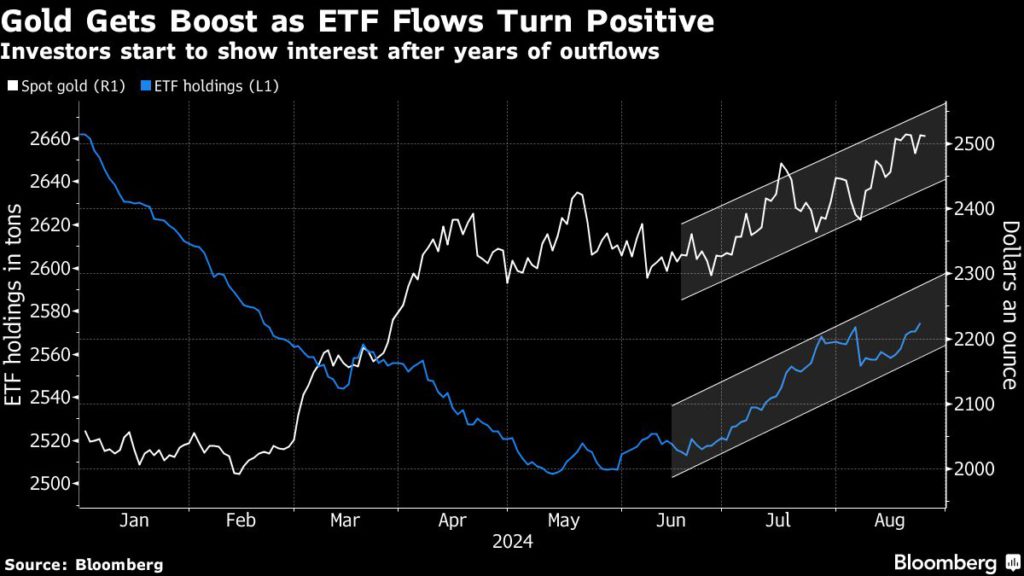Gold bulls delight in Jackson Hole as Powell juices price rally

Gold’s record-setting rally above $2,500 an ounce looks to have further to run as the Federal Reserve prepares to chop rates, traditional drivers such as lower yields return, and Western investors pile back in.
“Everybody thought the Fed was going to be the last to cut, but now they’re getting in line,” said Jay Hatfield, chief executive officer of Infrastructure Capital Advisors, who recently went long on gold options for the first time in years. Chair Jerome Powell’s Jackson Hole speech — which promised rate cuts — was a watershed moment for bullion, according to Hatfield.

Bullion has dazzled this year, setting a procession of records that marked out the precious metal as one of the strongest performers among major commodities. Its ascent in the first half came courtesy of strong central-bank buying plus Asian purchases, which offset the drag from a rising US dollar, higher Treasury yields, and outflows from bullion-backed exchange-traded funds. Now all three of those drivers may run in gold’s favor.
“That opportunity cost of holding gold is coming down,” said Rajeev De Mello, global macro portfolio manager at GAMA Asset Management SA. “This very fast decline in real yields, and the weakening of the dollar generally, makes me quite happy to use gold as another currency to be short the dollar.”
So far in 2024, spot gold has rallied by more than a fifth, with banks including Goldman Sachs Group Inc. saying as far back as April that prices had the scope to hit $2,700 an ounce. After Powell’s roadmap at the Jackson Hole symposium on Friday, US 10-year real yields have now retreated to the lowest since December. That benefits gold as it doesn’t pay interest.
Among investors, interest has become more widespread. Hedge funds and speculators have been adding bullish wagers on Comex — with net-long bullion positions hitting the highest in more than four years, according to Commodity Futures Trading Commission data.
There are also signs of a revival in demand for gold-backed ETFs. Holdings in SPDR Gold Shares, one of the leading products, have expanded for the eight straight weeks, the longest run of inflows since mid-2020.
To be sure, even with Western investors warming to the metal, prices may be vulnerable to softening consumption in Asia, where lofty prices have hurt demand. China’s central bank also recently paused its monthly purchases, weakening two of the pillars that helped lift gold in the first half.
For now, Citigroup Inc. sees inflows into ETFs expanding “significantly” over six to 12 months, with demand bolstered by looser monetary policy, as well as a potential increase in volatility amid recessionary risks. Gold may reach $3,000 by mid-2025, the bank said in a note before Powell’s address. Spot bullion traded at $2,525.73 an ounce at 9:18 a.m. in New York, close to its peak.
The market can expect large ETF flows, as well as ongoing speculator demand, when the Fed actually makes its first rate cut, according to UBS Group AG, which sees prices at $2,600 for the last quarter of this year. Increasing geopolitical risks should also lift demand for portfolio hedges, said Wayne Gordon, commodities strategist at UBS Global Wealth Management.
“It’s really notable that people are actually starting to move to that physical gold ETF side now,” said Ryan McIntyre, managing partner at Sprott Inc., a Toronto-based precious metals and critical minerals asset manager with $31.1 billion in assets under management. “Buying through the ETFs is going to be a big, big part of gold’s story.”
(By Sybilla Gross and Yvonne Yue Li)
Read More: Want to capitalize on all-time high gold price? You could be in business by 2040!
{{ commodity.name }}
{{ post.title }}
{{ post.date }}

Comments